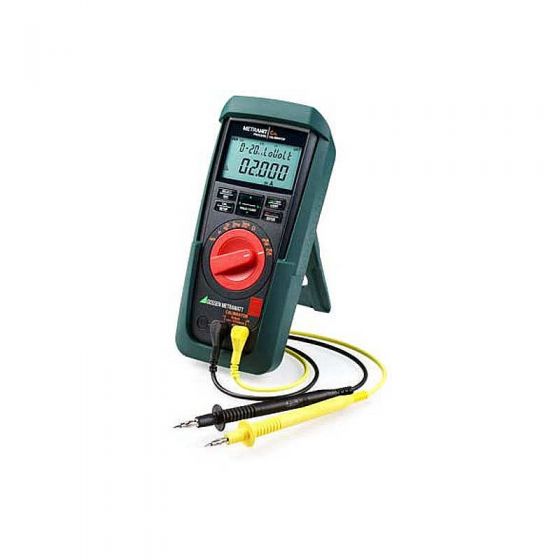We use cookies to make your experience better. To comply with the new e-Privacy directive, we need to ask for your consent to set the cookies. Learn more.
System Components and Range of Applications
Integrated electronics generate mV, V and mA signals. Beyond this, they’re capable of simulating thermo-voltages for various types of thermocouples for predefined temperatures (°C or °F), as well as resistance values for various Pt and Ni temperature sensors.
Continuous frequency signals can be transmitted by the METRAHIT CAL for testing SPCs, energy metering devices, flow rates and more. Amplitude is adjustable for the generated square-wave pulses, which are used to simulate sensor pulses. Predefined pulse runs are also transmitted at a given frequency.
Measuring transducers with a wide variety of input signals (voltage, thermo-voltage, RTD and 2-wire resistance sensors etc.) can be directly connected and calibrated. If a multimeter is used (e.g. METRAHIT X-TRA), the respective values can be measured at the measuring transducer’s output, transmitted to a PC via an adapter if desired, displayed with the help of optional METRAwin90-2 software and compared with the appropriate calibration specifications. Setpoint values and actual values are displayed, or printed as a certificate. When operated in the “mA sink” mode, the METRAHIT CAL simulates a 2-wire transmitter and retrieves the selected current value from the measuring sequence.
Depending upon individual needs, desired dynamic response can be derived from, for example, the full-scale value and the number of intermediate steps (intervals), or rise and dwell periods (ramp). This is especially helpful for long-term testing of laboratory and panel recorders, as well as measuring transducers, and for “one-man” control rooms.
Temperature Simulation
Temperature for the external reference junction can be set at the calibrator or with a PC. This eliminates the need to connect the device to be calibrated with the calibrator via the respectively required compensating lead. A copper conductor between the calibrator and the device to be calibrated is sufficient in this case.
Internal clock
Time format DD.MM.YYYY hh:mm:ss
Resolution 0.1 s
Accuracy ±1 minute per month
Temp. influence 50 ppm/K
Display
LCD panel (65 x 36 mm) with digital display including simulation
unit of measure and various special functions
Background Illumination
Background illumination is switched off approximately 1 minute
after it has been activated.
Display / char. height 7-segment characters
Main display: 1 x 6 digits, 12 mm
Auxiliary displays: 2 x 6 digits, 7 mm
Max. resolution 30000
Polarity display “–” (minus sign) is displayed
Refresh Rate 2 times per second, every 500 ms
Power Supply
Battery 2 AA size batteries,
alkaline manganese per IEC LR6
(2 ea. 1.2 V NiMH rechargeable battery also possible)
Service life With alkaline manganese (2600 mAh)
If voltage drops below 1.8 V, the instrument is switched off automatically.
Battery Indicator Battery capacity display with battery symbol in 4 segments.
Querying of momentary battery voltage via menu function.
Power Saving Circuit
The device is switched off automatically if none of the controls are
activated for a period of approximately 10 minutes. The simulator
is switched off after a period of only 5 minutes (sockets are current
and voltage-free). Automatic shutdown can be deactivated.
Power pack socket If the NA X-TRA power pack is plugged in,
the installed batteries are disconnected
automatically.
Rechargeable batteries can only be
recharged externally.
Fuses
Fuse link FF0,63A/700V, 6,3 mm x 32 mm, min. 1,5 kA switching capacity
Electrical Safety
Protection class II per EN 61010-1:2010/VDE 0411-1:2011
Operating voltage Max. 50 V
Measuring category I (250 V)
Pollution degree 2
Test voltage 500 V~ per EN 61010-1:2010/VDE 0411- 1:2011
Electromagnetic Compatibility (EMC)
Interference emission EN 61326-1: 2006 class B
Interference immunity EN 61326-1: 2006
EN 61326-2-1: 2006
Data Interface
Type Optical via infrared light through the housing
Data transmission Serial, bidirectional (not IrDa compatible)
Protocol Device specific
Baud rate 38,400 baud
Functions Set/query cal. functions and parameters
The USB X-TRA plug-in interface adapter (see accessories) is used
for adaptation to the PC’s USB port.
Ambient Conditions
Accuracy range 0 °C … +40 °C
Operating temp. range −10 °C … +50 °C
Storage temp. range −25 °C … +70 °C (without batteries)
Relative humidity 40% … 75%, no condensation allowed
Elevation To 2000 m
Mechanical Design
Housing Impact resistant plastic (ABS)
Dimensions 200 x 87 x 45 mm
(without protective rubber holster)
Weight Approx. 0.35 kg with batteries
Protection IP 54
(pressure equalization via the housing)




